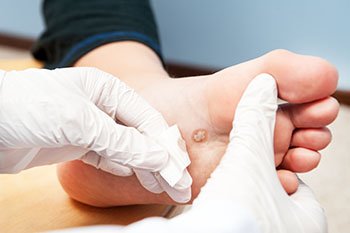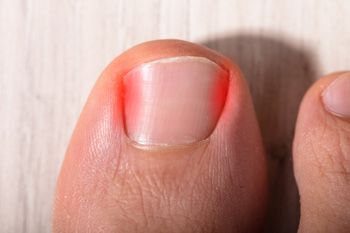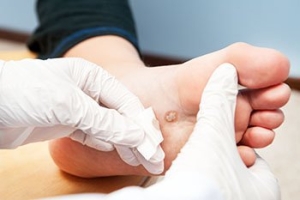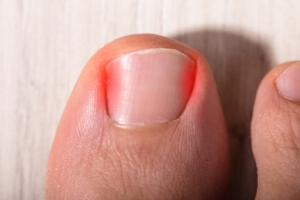
What Do Plantar Warts Look Like?
 Warts on the bottom of the feet, known as plantar warts, are caused by a viral infection called HPV. Plantar warts can appear anywhere on the bottom of the foot. They are more common on the foot’s pressure points, such as the heel, toes, and balls of the foot. A plantar wart may appear by itself, or appear as multiple warts. Sometimes, multiple warts come together to form what looks like a firm, thickened plaque over a specific area on the bottom of the foot. The warts themselves may be gray, brown, yellow, or flesh-colored. Often tiny black dots, which are actually small, dilated blood vessels, can be seen on the surface of the warts. Sometimes plantar warts can become calloused or grow into the foot, which can make walking uncomfortable. If you have warts on the bottom of your feet, please consult with a podiatrist.
Warts on the bottom of the feet, known as plantar warts, are caused by a viral infection called HPV. Plantar warts can appear anywhere on the bottom of the foot. They are more common on the foot’s pressure points, such as the heel, toes, and balls of the foot. A plantar wart may appear by itself, or appear as multiple warts. Sometimes, multiple warts come together to form what looks like a firm, thickened plaque over a specific area on the bottom of the foot. The warts themselves may be gray, brown, yellow, or flesh-colored. Often tiny black dots, which are actually small, dilated blood vessels, can be seen on the surface of the warts. Sometimes plantar warts can become calloused or grow into the foot, which can make walking uncomfortable. If you have warts on the bottom of your feet, please consult with a podiatrist.
Plantar warts can be very uncomfortable. If you need your feet checked, contact one of our podiatrists from PA Foot & Ankle Associates. Our doctors will assist you with all of your foot and ankle needs.
About Plantar Warts
Plantar warts are the result of HPV, or human papillomavirus, getting into open wounds on the feet. They are mostly found on the heels or balls of the feet.
While plantar warts are generally harmless, those experiencing excessive pain or those suffering from diabetes or a compromised immune system require immediate medical care. Plantar warts are easily diagnosed, usually through scraping off a bit of rough skin or by getting a biopsy.
Symptoms
- Lesions on the bottom of your feet, usually rough and grainy
- Hard or thick callused spots
- Wart seeds, which are small clotted blood vessels that look like little black spots
- Pain, discomfort, or tenderness of your feet when walking or standing
Treatment
- Freezing
- Electric tool removal
- Laser Treatment
- Topical Creams (prescription only)
- Over-the-counter medications
To help prevent developing plantar warts, avoid walking barefoot over abrasive surfaces that can cause cuts or wounds for HPV to get into. Avoiding direct contact with other warts, as well as not picking or rubbing existing warts, can help prevent the further spread of plantar warts. However, if you think you have developed plantar warts, speak to your podiatrist. He or she can diagnose the warts on your feet and recommend the appropriate treatment options.
If you have any questions please feel free to contact one of our offices located in Allentown, Easton, Northampton, and Chew Street in Allentown, PA . We offer the newest diagnostic and treatment technologies for all your foot and ankle needs.
All About Plantar Warts
Plantar warts are warts that are only found on the feet, hence the term “plantar”, which means “relating to the foot.” They are caused by the human papillomavirus, or HPV, and occur when this virus gets into open wounds on the feet. The warts themselves are hard bumps on the foot. They are easily recognizable, mostly found on the heels or ball of the foot. Plantar warts are non-malignant, but they can cause some pain, discomfort, and are often unsightly. Removing them is a common step toward treating them.
Plantar warts can cause some pain while standing, sometimes felt as tenderness on the sole of your foot. Unless the wart has grown into the foot behind a callus, you will be able to see the fleshy wart. A podiatrist should only be consulted if there is an excessive amount of pain. Plantar warts are not cancerous or dangerous, but they can affect your walking and continually reappear. Anyone who suffers from diabetes or a compromised immune system disease should seek out care immediately.
Podiatrists are easily able to diagnose plantar warts. They usually scrape off a tiny bit of the rough skin to make tiny blood clots visible and examine the inside of warts. However, a biopsy can be done if the doctor is not able to diagnose them from simply looking at them. Although plantar warts usually do not require an excessive amount of treatment, there are ways to go about removing them. A common method is to freeze them off using liquid nitrogen, removing them using an electrical tool, or burning them off via laser treatment. For a less invasive treatment option, topical creams can be used through a doctor’s prescription. This treatment method takes more time, however. Keep the wart covered for protection in between daily treatments.
The best way to avoid developing plantar warts is to avoid walking barefoot in public places. Avoid this especially if you have open sores or cuts on your feet. It is also important to avoid direct contact with warts in general, as they are highly contagious.
Can I Ignore My Ingrown Toenail?
 Ingrown toenails occur when the edge of a toenail grows into the skin surrounding the nail. This can cause the skin around the nail to become red, painful, and swollen. If left untreated, an ingrown toenail can damage the skin and expose the area to bacteria, leading to an infection. Home treatments for ingrown toenails include soaking the affected foot in warm water, applying a topical antibiotic ointment to the skin and covering it with a bandage, and wearing wider shoes to keep pressure off of the affected toe. If home treatments do not help, or if you have diabetes, poor circulation, or peripheral neuropathy, it is suggested that you see a podiatrist for treatment.
Ingrown toenails occur when the edge of a toenail grows into the skin surrounding the nail. This can cause the skin around the nail to become red, painful, and swollen. If left untreated, an ingrown toenail can damage the skin and expose the area to bacteria, leading to an infection. Home treatments for ingrown toenails include soaking the affected foot in warm water, applying a topical antibiotic ointment to the skin and covering it with a bandage, and wearing wider shoes to keep pressure off of the affected toe. If home treatments do not help, or if you have diabetes, poor circulation, or peripheral neuropathy, it is suggested that you see a podiatrist for treatment.
Ingrown toenails can become painful if they are not treated properly. For more information about ingrown toenails, contact one of our podiatrists of PA Foot & Ankle Associates. Our doctors can provide the care you need to keep you pain-free and on your feet.
Ingrown Toenails
Ingrown toenails occur when a toenail grows sideways into the bed of the nail, causing pain, swelling, and possibly infection.
Causes
- Bacterial infections
- Improper nail cutting such as cutting it too short or not straight across
- Trauma to the toe, such as stubbing, which causes the nail to grow back irregularly
- Ill-fitting shoes that bunch the toes too close together
- Genetic predisposition
Prevention
Because ingrown toenails are not something found outside of shoe-wearing cultures, going barefoot as often as possible will decrease the likeliness of developing ingrown toenails. Wearing proper fitting shoes and using proper cutting techniques will also help decrease your risk of developing ingrown toenails.
Treatment
Ingrown toenails are a very treatable foot condition. In minor cases, soaking the affected area in salt or antibacterial soaps will not only help with the ingrown nail itself, but also help prevent any infections from occurring. In more severe cases, surgery is an option. In either case, speaking to your podiatrist about this condition will help you get a better understanding of specific treatment options that are right for you.
If you have any questions please feel free to contact one of our offices located in Allentown, Easton, Northampton, and Chew Street in Allentown, PA . We offer the newest diagnostic and treatment technologies for all your foot and ankle needs.
Ingrown Toenails
Ingrown toenails (onychocryptosis) are a common foot ailment and it is very unpleasant to experience. The condition is caused by an increase in pressure from the ingrowth of the nail edge into the skin of the toe. Ingrown toenails commonly cause pain in those who experience them. In some cases, the skin surrounding the ingrown toenail may break which may lead bacteria to enter through and cause an infection. Common symptoms of this ailment include pain, redness, swelling, and warmth around the toe.
An imbalance between the size of the nail and the enlargement of the nail skin edge causes ingrown toenails. This condition is often caused by improperly trimming the toenails. If you are trying you cut your nails, you should always try to trim straight across instead of in a rounded shape. Ingrown toenails can also be an inherited condition and they may also be caused by improper shoe fitting.
Another common cause of the condition is wearing shoes that are either too small or too large. Other causes include poor foot hygiene, obesity, diabetes, arthritis, edema, and fungal infections. There are many risk factors that may make a person more likely to develop an ingrown toenail. Athletes who play “stop and start” sports such as tennis, soccer, and basketball are most likely to have ingrown toenails.
People who have diabetes, a compromised immune system, or poor circulation should immediately seek care from a podiatrist if they have an ingrown toenail. It is also recommended to seek professional assistance if at-home remedies are not successful within a week or if there is persistent pain.
How Diabetes Impacts the Feet
 The medical condition that is known as diabetes is considered to be a metabolic disorder. This is a disease that gradually develops as a result of elevated blood sugar levels, and generally falls into two categories. Type 1 diabetes is known to be an autoimmune disorder, and may appear in early childhood. Obesity may be a contributing factor in developing type 2 diabetes, and in many patients, occurs after the age of forty. High blood sugar levels may cause a loss of sensation in the feet, and it can become difficult to feel existing cuts and foot wounds. Diabetic patients may find it helpful to perform daily foot checks, and this can be beneficial to noticing any cuts or bruises that are present. If you have diabetes, it is strongly suggested that you are under the care of a podiatrist who can help you to manage this condition.
The medical condition that is known as diabetes is considered to be a metabolic disorder. This is a disease that gradually develops as a result of elevated blood sugar levels, and generally falls into two categories. Type 1 diabetes is known to be an autoimmune disorder, and may appear in early childhood. Obesity may be a contributing factor in developing type 2 diabetes, and in many patients, occurs after the age of forty. High blood sugar levels may cause a loss of sensation in the feet, and it can become difficult to feel existing cuts and foot wounds. Diabetic patients may find it helpful to perform daily foot checks, and this can be beneficial to noticing any cuts or bruises that are present. If you have diabetes, it is strongly suggested that you are under the care of a podiatrist who can help you to manage this condition.
Diabetic foot care is important in preventing foot ailments such as ulcers. If you are suffering from diabetes or have any other concerns about your feet, contact one of our podiatrists from PA Foot & Ankle Associates. Our doctors can provide the care you need to keep you pain-free and on your feet.
Diabetic Foot Care
Diabetes affects millions of people every year. The condition can damage blood vessels in many parts of the body, especially the feet. Because of this, taking care of your feet is essential if you have diabetes, and having a podiatrist help monitor your foot health is highly recommended.
The Importance of Caring for Your Feet
- Routinely inspect your feet for bruises or sores.
- Wear socks that fit your feet comfortably.
- Wear comfortable shoes that provide adequate support.
Patients with diabetes should have their doctor monitor their blood levels, as blood sugar levels play such a huge role in diabetic care. Monitoring these levels on a regular basis is highly advised.
It is always best to inform your healthcare professional of any concerns you may have regarding your feet, especially for diabetic patients. Early treatment and routine foot examinations are keys to maintaining proper health, especially because severe complications can arise if proper treatment is not applied.
If you have any questions please feel free to contact one of our offices located in Allentown, Easton, Northampton, and Chew Street in Allentown, PA . We offer the newest diagnostic and treatment technologies for all your foot and ankle needs.
Diabetic Foot Conditions
According to the American Diabetes Association (ADA), diabetes is a condition that affects approximately 23.6 million Americans. Around 750,000 new cases are diagnosed each year, and the disease’s most common form, Type 2 diabetes, makes up for 90 to 95 percent of these cases. Type 2 diabetes is especially prevalent among older Americans, those who are obese, and those who lead sedentary lifestyles.
Complications of the disease may lead to several foot and ankle-related conditions. The loss of nerve sensation, or neuropathy, can cause diabetics to lose feeling at the bottom of the feet and therefore leave them unaware of pain, pressure, and heat. Decreased circulation is another complication of diabetes that can slow down the healing of wounds and injuries; this can lead to the development of foot ulcers.
To prevent foot ulcers from forming, diabetics should examine their feet every day for small cuts and wear shoes that curtail pressure. Constant monitoring for the risk factors associated with ulcer formation can allow for early detection and therefore lessen the possibility of ulcers or, even worse, amputation. The removal of calluses and ingrown toenails should be left to the podiatrist to avoid improper removal and possible infection.
Diabetic patients may also experience foot deformities due to complications in their feet, such as limited joint mobility, muscle atrophy, and decreased fat padding. These complications can increase pressure in certain areas of the foot, which in turn can cause certain deformities, such as hammertoe, to form. Another deformity, Charcot foot, develops due to the collapsing of microfractures in the bones of the feet. The resulting deformity is a foot that is flattened and wider in appearance.
To help minimize pressure and prevent the development of these diabetes-related foot and ankle conditions, your podiatrist may consider using orthotics or special shoes. Charcot foot may be treated using walkers, custom orthotic insoles, or non-weight-bearing or rigid weight-bearing casts or braces. In more serious cases, surgery may be considered to treat more developed deformities. Ulcers can be further cared for with the help of proper diet, medication to control glucose, intensive wound care, and infection treatment.
Wounds That Don't Heal Need to Be Checked
How Does an Ankle Sprain Happen?
 An ankle sprain is a common form of foot pain. Many people have endured ankle sprains at some point in their lives, and this type of injury can cause severe pain and discomfort. An ankle sprain is the result of ligaments that have been overstretched, and it may be difficult to walk and complete daily activities. It can happen when the ankle rolls outward, and the foot turns inward. People who enjoy running, and participating in jumping activities may be prone to ankle sprains. Some of the symptoms that are associated with this ailment can include immediate swelling, bruising, and the affected area is often tender. After a proper diagnosis is made, which generally involves having an X-ray taken, the correct treatment can begin. Mild relief may be found when the foot is wrapped in an elastic bandage, and this is helpful in providing adequate support as the healing process occurs. If you have sprained your ankle, please consult with a podiatrist who can effectively treat this condition.
An ankle sprain is a common form of foot pain. Many people have endured ankle sprains at some point in their lives, and this type of injury can cause severe pain and discomfort. An ankle sprain is the result of ligaments that have been overstretched, and it may be difficult to walk and complete daily activities. It can happen when the ankle rolls outward, and the foot turns inward. People who enjoy running, and participating in jumping activities may be prone to ankle sprains. Some of the symptoms that are associated with this ailment can include immediate swelling, bruising, and the affected area is often tender. After a proper diagnosis is made, which generally involves having an X-ray taken, the correct treatment can begin. Mild relief may be found when the foot is wrapped in an elastic bandage, and this is helpful in providing adequate support as the healing process occurs. If you have sprained your ankle, please consult with a podiatrist who can effectively treat this condition.
Ankle pain can have many different causes and the pain may potentially be serious. If you have ankle pain, consult with one of our podiatrists from PA Foot & Ankle Associates. Our doctors will assess your condition and provide you with quality foot and ankle treatment.
Ankle pain is any condition that causes pain in the ankle. Due to the fact that the ankle consists of tendons, muscles, bones, and ligaments, ankle pain can come from a number of different conditions.
Causes
The most common causes of ankle pain include:
- Types of arthritis (rheumatoid, osteoarthritis, and gout)
- Ankle sprains
- Broken ankles
- Achilles tendinitis
- Achilles tendon rupture
- Stress fractures
- Tarsal tunnel syndrome
- Plantar fasciitis
Symptoms
Symptoms of ankle injury vary based upon the condition. Pain may include general pain and discomfort, swelling, aching, redness, bruising, burning or stabbing sensations, and/or loss of sensation.
Diagnosis
Due to the wide variety of potential causes of ankle pain, podiatrists will utilize a number of different methods to properly diagnose ankle pain. This can include asking for personal and family medical histories and of any recent injuries. Further diagnosis may include sensation tests, a physical examination, and potentially x-rays or other imaging tests.
Treatment
Just as the range of causes varies widely, so do treatments. Some more common treatments are rest, ice packs, keeping pressure off the foot, orthotics and braces, medication for inflammation and pain, and surgery.
If you have any questions, please feel free to contact one of our offices located in Allentown, Easton, Northampton, and Chew Street in Allentown, PA . We offer the newest diagnostic and treatment technologies for all your foot care needs.










